More coffee, less caffeine: Intel 9th Gen (part 3)
- Transfer
Part 1 → Part 2 → Part 3 → Part 4
Despite the fact that World of Tanks is very different from most other frequently played massively multiplayer online games, it allows the player to find himself in the middle of the 20th century and control a number of armored combat vehicles. World of Tanks (WoT) is developed and published by Wargaming, which are based in Belarus, and the soundtrack for the game is mainly written by the Belarusian composer Sergei Khmelevsky. The game offers several entry points, including free-to-play, and also allows players to pay for additional features. One of the most interesting facts about this tank-based MMO is that it reached eSports status when it debuted at World Cyber Games back in 2012.
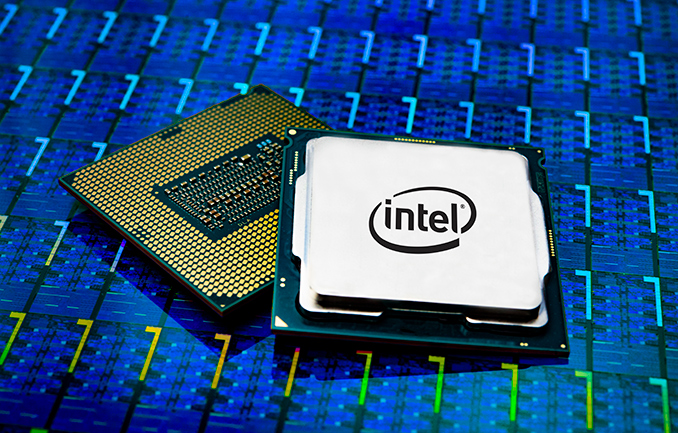

World of Tanks enCore is a demo application for a new and unreleased graphics engine created by the Wargaming development team. Over time, the new main engine will be implemented in the full game, updating the game visual effects in the most key elements, such as improved water, flora, shadows, lighting, as well as other objects. The World of Tanks enCore demo application not only reveals information about upcoming changes in the game engine, but also allows users to check the system performance to make sure that the home system processes the new engine normally.

Being a game that is not particularly limited to the GPU — at least not at low image quality settings — World of Tanks gives the 9900K processor a lot of space to show off. The game is not particularly sensitive to the number of cores, so we are talking about the high performance of each stream. And in this case, the 9900K with its turbo 5.0GHz flies forward. In fact, I am surprised at how far it has bypassed the 8086K (by 16%); this may be one of the biggest gains from 9900K, capable of raising turbo to 5.0 GHz on two cores, compared to one core on 8086K.
9700K also makes a strong impression in this test, second only to 9900K. We have several theories about this - including whether the lack of simultaneous multithreading is a plus or a minus - but nevertheless, it is obvious that the new CFL-R CPUs occupy the top two places.
However, there is a downside: any result based on processor performance melts with higher image quality settings. By the time we reached the maximum quality, the performance turned out to be limited by the capabilities of the GPU.
Upon arrival to the computer not so long ago, the graphics of Final Fantasy XV: Windows Edition was redone because it was transferred from the console, as a result of their successful partnership with NVIDIA, with almost no mention of the production and development of the original Final Fantasy XV.
In preparation for the launch, Square Enix decided to release a stand-alone benchmark, which they recently updated. The use of stand-alone benchmark Final Fantasy XV gives us a long-term and reliable point of reference. Although it should be noted that the intensive use of NVIDIA technology by the benchmark means that it has problems with “maximum” parameters - it renders elements off-screen. To get around this, we use a standard preset that does not have these problems.

Square Enix patched the benchmark with custom graphic settings, and made corrections to give a more accurate result in the profiling of game performance, and the graphic parameters in the game. For testing, we run a standard benchmark with FRAP overlay using a 6-minute test record.

The next step is in Middle-earth: Shadow of War, the sequel to Shadow of Mordor. Published by Monolith, the last hit of which may have been FEAR, Shadow of Mordor brought the company back to the spotlight thanks to an innovative system for creating and interacting NPC rivals, under the name Nemesis System, as well as a storyline based on Tolkien's legends. The game runs on a highly modified engine, which was originally used in FEAR in 2005.

With the new engine LithTech Firebird, Shadow of War has improved the detail and complexity, as well as complemented by free high-resolution texture packages. The game offers itself as a good example - how to get the most beautiful graphics from a not very cool engine. Shadow of War also supports HDR (HDR10).

Shadow of War is another game in which it is difficult to see the limitations of the processor with reasonable game settings. Even 1080p Ultra is a bundle of Intel processors that compete who first stumbles at more than 100 frames per second, with AMD right on its tail. The less-sensible 720p Ultra widened the gap a bit - processors with weak thread performance are beginning to fall behind - but this is still a very similar result for all Coffee Lake processors. With the highest frequencies, with a large number of cores for a desktop processor, the 9900K turns out to be the strongest contender. But this is not a game that can use all the performance of this processor.
Originally launched by Sid Meier and his team, the Civ series of turn-based strategies became a cult classic. Many apologies were made for the sleepless nights of the players, who could not make Gandhi go to war because of the overflow of whole numbers. In truth, I have never played the first version, but I played in every part from the second to the sixth, including the fourth, voiced by the late Leonard Nimy. This is a game that is easy to play, but hard to play well.
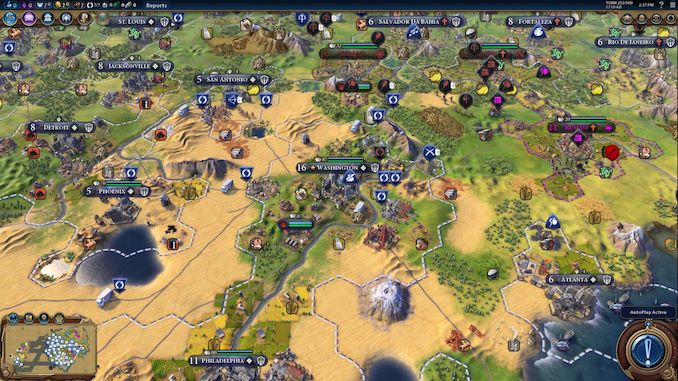
Civilization benchmarking has always been something like an oxymoron - for a turn-based strategy game the frame rate is not particularly important, and with the right mood, only 5 frames per second is enough for a good game. However, with Civilization 6, Firaxis has hit hardcore and raised the visualization bar, trying to get you involved in the game. As a result, Civilization may require from the player a new video card and processor, especially if you play with high details under DirectX 12.
Perhaps a more in-demand result will be visible during a late game, when, in older versions, it could take 20 minutes for Civilization to make the AI players move, and transfer control to the person. The new version of Civilization has an integrated “AI Benchmark”, although at present it is not yet included in our portfolio of tests for technical reasons that we are trying to solve. Instead, we run a graphical test, which provides an example of average game settings in options.

Continuing the theme voiced earlier, Civilization 6 is another game in which 9900K does give advantages, but not in any situation. Firstly, the game doesn’t particularly rely on the GPU, so at 4K Ultra we are still not completely limited by the video card; but after about Ryzen 7 2700X, all processors start working the same way. We have to reduce the settings to 1080p Ultra in order to pull the CPU apart in different directions, after which 9900K is ahead.
This is another game that is apparently not concerned with the number of cores, as well as the frequency. Thus, 9900K has the first place, and 9700K - the second. But none of them went far from the 8700K, and the latest Intel processors are only 12% faster than their former flagship, even in these comfortable benchmark settings for the CPU.
Curiously, we also see that the 9900K loses to the 9700K processor at 4K resolution and higher. The difference is quite small and is within the margin of error, but it can be a very insignificant effect of the fact that lower-level chips should not compete for their cores for the sake of hyper-threading.
The beloved child of DirectX12, Ashes of the Singularity (AoTS or simply Ashes) was the first name to actively explore as many DirectX12s features as possible. Stardock, the developer of the Nitrous engine that runs the game, made sure that the real-time strategy takes advantage of several cores and several video cards in the maximum possible set of configurations.

As real-time strategy is supposed to be, Ashes is a quick response both during wide open species and in mass battles. With DirectX12 at the helm, the ability to make more calls per second allows the engine to work with a significant depth of drawing units and effects. At the same time, some other RTSs had to rely on combined drawing, making the combined unit structures very rigid.
Stardock well understands the need for an internal benchmark test in the game, ensuring that this tool is available and operational from the day the game is released. This is especially important given the use of all the new features of the DX12, since it was important for the developer to understand how they affected the game. The in-game test performs a four-minute fixed battle scene with multiple shots and displays a huge amount of data for analysis.
For our test, we run Ashes Classic - an older version of the game, before updating Escalation. The old version is easier to automate, it does not use splash screen, but still has good visual accuracy for testing.

Ashes has a drop-down menu with settings for MSAA, Light Quality, Object Quality, Shading Samples, Shadow Quality, textures and individual settings for the landscape. There are several presets, from Very Low to Extreme. We run our tests on various settings and derive the average FPS and 95th percentile.
As a game that was designed right from the start to make processors boil, and to demonstrate the benefits of DirectX 12 APIs, Ashes is one of the most CPU-sensitive tests. Above 1080p, the results are still almost the same due to the limits of the GPU's capabilities, but at 1080p or lower we get some visual separation. In this case, we see that the 9900K shows a slight advantage, putting it in first place, somewhat overtaking the 9700K that follows right behind it.
It is noteworthy that the game does not scale very much from 1080p to 720p. This makes me suspect that we are looking at a relatively clean processor shortage, a rarity in modern games. In our case, this is both good and bad for the latest Intel processor; this is by far the fastest chip here, but it doesn’t show a big margin to separate itself from the similar 8700K, having only a 4% advantage at 1080p. And this is despite its frequency and advantage in the number of cores. Thus, assuming that we do not run into the limit of the GPU, it means that we found another bottleneck (memory bandwidth? Or, perhaps, the frequency increase by 9900K does not have much weight here.
But, among other things, the 9900K and even the 9700K do really well compared to the 9600K. Whether this is a result of the number of cores or high frequency, there is a 10% advantage to these fast processors at 1080p.
Strange Brigade takes the player to Egypt in 1903 and follows a story that is very similar to the story of the Mummy movie series. This typical third-person shooter was developed by Rebellion Developments, which is more widely known for its Sniper Elite and Alien vs Predator games. The game follows the idea of hunting for the Tzetkas - the Witch Queen. The gameplay is focused on the cooperative passage, with a wide arsenal of various levels and a lot of puzzles that will be solved by a group of British agents of the colonial secret service, whose goal is to put an end to its reign of barbarism and cruelty.

The game supports both the DirectX 12 API and the Vulkan API and includes its own built-in test, which offers various settings, including textures, anti-aliasing, reflections, rendering distance, and even allows users to enable or disable image blur, ambient occlusion, tessellation, etc. . Earlier, AMD boasted that Strange Brigade uses its own Vulkan API integration, which implies scalability when using several AMD graphics cards on a player's machine.

Strange Brigade is another game in which it is difficult to share the results of the CPU with the default settings. We are clearly limited to the GPU at 1080p resolution, and must go down to a minimum of 720p in order to evaluate the processors. As soon as we do this, the 9900K takes the lead, and the 9700K follows right behind it. Here, the latest generation of Intel flagships is still working, and is able to offer more than a 5% performance advantage over last year’s leader. By the way, did I mention that all processors are faster than 7700K, delivering 400 frames per second or better?
The long-awaited iteration of the Grand Theft Auto franchise hit the shelves on April 14, 2015, and AMD and NVIDIA made efforts to optimize the game. There are no graphic presets in GTA, but still the game opens up new possibilities for users and expands the boundaries of modern graphics, loading even the most powerful computers to the limit with the aid of the Rockstar Advanced Game Engine under DirectX 11. Regardless of whether the user flies high in the mountains, where you need to draw the world at long distances, or deal with sorted garbage in the city, when it is bent to the maximum, the game creates stunning visual effects, plus hard work for both the processor and the graphics card.

For testing, we wrote several scripts for the benchmark built into the game. The internal benchmark will include five scenarios: four short panoramic scenes with variable lighting and weather effects, plus a fifth - a sequence of actions lasting about 90 seconds. We decided to use only the last scene: it includes a jet flight, then a car ride through the city through several intersections, and at the end - a collision with a gasoline tank truck that explodes, like the cars around it. This is a great combination of long-distance rendering, followed by short-range rendering. And fortunately, the game gives all the necessary test results.

There are no graphical presets in GTA, but the user can manually adjust parameters such as population density and drawing distance using the sliders. Other parameters such as texture / shadow / shaders / water quality switch from low quality to very high. Other settings include MSAA, soft shadows, post effects, shadow resolution, and advanced remote rendering settings. At the top of the screen there is a convenient option that shows how much video memory the game will consume with these parameters, with obvious consequences if the user requests more video memory than he has on the card (although there is no obvious hint if you have a weak GPU with more video memory, for example, R7 240 4 GB).
GTA V has always been a very exciting game, and not only because of its criminal bias. Originally released for the latest generation of consoles a few years ago - with the best processors and graphics processors from 2005/2006 - it still sells well. More importantly, it can still squeeze juices from a modern video card. And the processors are also not very easy to cope with the game, especially at high 1080p settings. In this case, CFL-R chips take 1-2-3 places, and further up to 8700K. The increase in performance is not very noticeable, but still 9900K improved performance compared with its predecessor by 9%.
However, these differences in processors quickly become irrelevant at higher, more demanding GPU settings. At 1440p Very High, we hardly see any difference in the 7 best processors, and no one issues more than 23 frames per second at 4K.
The last game in the Ubisoft Far Cry series directs us directly to the unkind hands of the militarist cult in Montana, to one of the many provincial places in the United States. With a charismatic and mysterious opponent, gorgeous landscapes of northwest America and lots of violence, this is classic Far Cry. Graphically loaded game in the open world, where fighting and research are mixed.
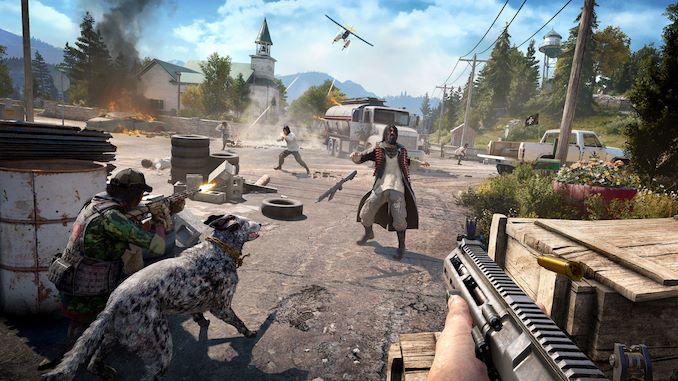
Far Cry 5 supports Vega-oriented features with Rapid Packed Math and Shader Intrinsics. Far Cry 5 also supports HDR (HDR10, scRGB and FreeSync 2). We use the built-in benchmark to get data and report the average and minimum frame rates.

Far Cry 5 is another game that, with reasonable settings, 1080p can demonstrate some differentiation between processors. To really see the difference between the CPU, we need to reset the settings to 720p Low, but still, in both cases, 9900K comes out on top. And in this case, the performance gap between it and the 8700K is actually a bit more than usual, this is already 12%. Nevertheless, this game, although not very dependent on the GPU, uses a limited number of threads, so the lack of large clock frequencies at 9900K does not allow it to be too far away from its rivals. It also holds 9700K in high positions.
The latest representative of the Tomb Raider franchise avoids the sun, and prefers to hide in the shadows with the Shadow of the Tomb Raider. As expected, this action-adventure is again about Lara Croft, who is the main character of the franchise. Now she is making her way through the Mesoamerican and South American regions, trying to stop the Mayan apocalypse, which she herself unleashed. Shadow of the Tomb Raider is a direct continuation of the previous Rise of the Tomb Raider, was developed by Eidos Montreal and Crystal Dynamics and was published by Square Enix. The game hit the shelves in September 2018, and was released immediately for several platforms. This game actually closes the story of Lara Croft Origins, and received critical reviews after the release.

The integrated Shadow of the Tomb Raider benchmark is similar to the previous Rise of the Tomb Raider game, which we often used in the previous test suite. New Shadow of the Tomb Raider uses DirectX 11 and 12, and this particular game is advertised as one of the best implementations of DirectX 12 ever published.

Going deeper into the Shadow of Tomb Raider, we see another game that is mainly limited to the GPU in 1080p settings. At a resolution of 1080p, the 9900K suddenly finds itself one step behind the 7900K - a very unpleasant result, by the way, while at 720p Low it barely lags behind the 9700K. In any case, as soon as we lower our settings low enough to remove the bottleneck in the GPU, we see another typical result for the new CFL-R processors. The latest and most recent versions of Intel are several percent ahead of their predecessors, but none of the games we tested can really use the additional two cores. So all this is about frequencies and L3 caches.
Although this game (like many others) seems to reinforce the view that the 9600K is the new 8700K. The 8700K is still ahead a few frames at the settings associated with the CPU, but, despite the loss of the HT, the 9600K gives excellent results at a noticeably low price.
In addition to keeping the Formula 1 racing world up to date, F1 2017 added support for HDR, which F1 2018 also has. Otherwise, we would see how new versions of the Codemasters' EGO engine pave the way for F1. By claiming our rights to good graphics, F1 2018 provides a useful graphical load in our tests.
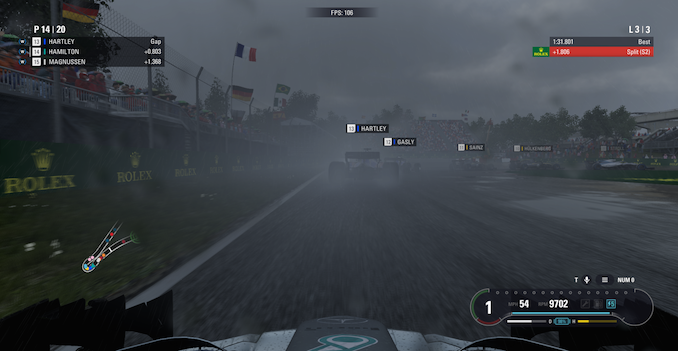
We use the built-in gaming test, which runs on the track in Montreal on a wet road, starting as Lewis Hamilton from the last place on the grid. Data is accepted for one lap race.

Our final (and most British) benchmark is another game that is not connected to the GPU right out of the box, so it allows the processors to work a little. At the average level of 1080p, 9900K and 9700K occupy top positions, although along with 8700K, this is all within the limits of measurement error. 9700K overtakes 9900K.
Reducing the settings to 720p leads to the fact that the gap between the processors increases, and at this point 9900K takes the first place, and 9700K - behind him. The end result here is the indicator: 9900K exceeds 8700K by about 13%.
However, as soon as we get to the 4K settings (quite reasonable for this game), the game becomes much more rigidly tied to the GPU. At this point, the differences in processor performance are purely theoretical.
Despite the fact that games on integrated graphics remain the main joke on events like “bring-your-own-computer”, the game on integrated graphics can end up being as interesting as on the newest mega-device costing in the car. Over the years, the pursuit of strong integrated graphics of various shapes and sizes has been gaining - and losing - momentum. Intel relies on its latest Gen architecture, while AMD is happy to bring Vega architecture to market to absorb the entire market for low-cost graphics. Taking into account Intel, ready to make an attack on the graphics in the next few years, it will be interesting to see how the graphics device market is developing, especially integrated graphics.

To test the integrated graphics, we use our “IGP” category settings for each game, and complete the test round within five minutes, using as much data from the automatic tuning as possible.
After the tests, looking at the performance of integrated graphics, I do not believe that we managed to surprise anyone. Intel has slightly changed its iGPU since Kaby Lake - the microarchitecture is the same, and the peak frequency of the GPU has grown from 50 MHz to 1200 MHz, so the results of Intel's iGPU over the past few years have almost stalled, even in the topmost desktop PC.




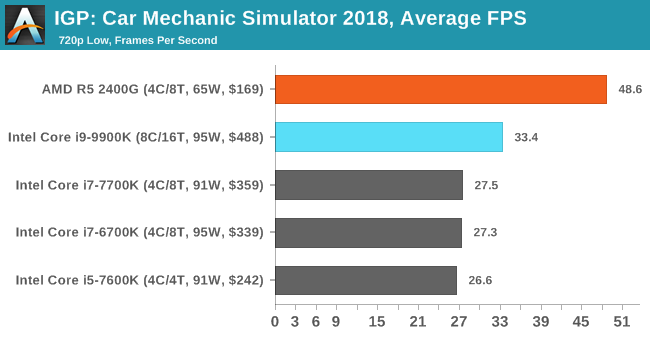
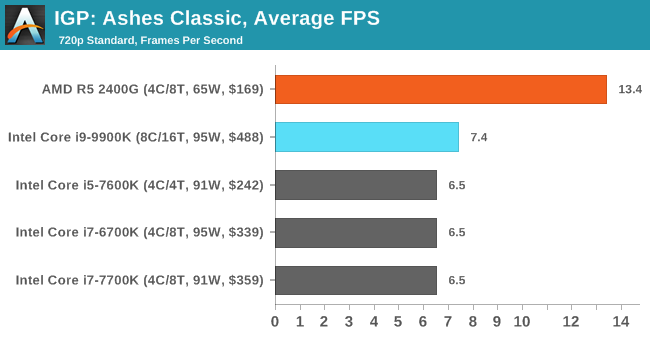
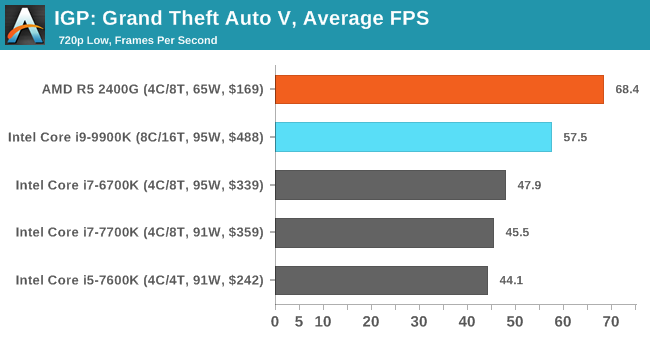
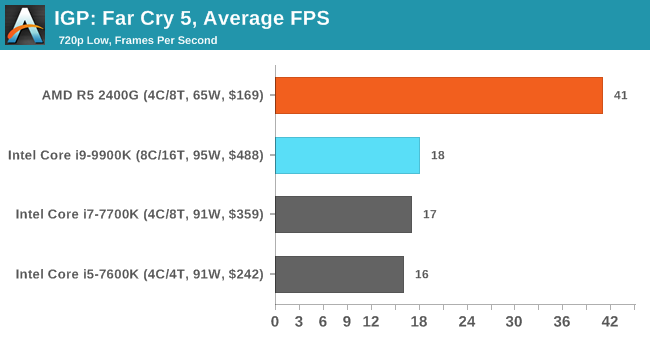
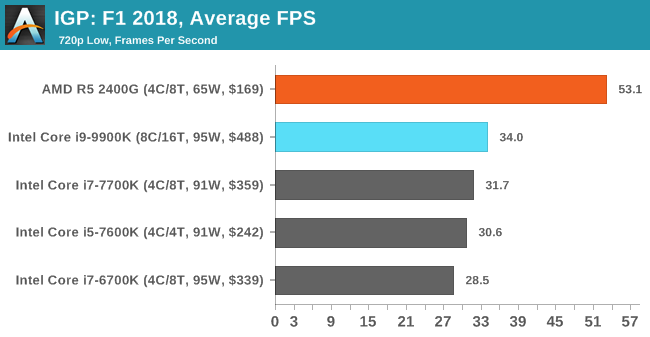
In the end, there is nothing special to tell. Intel GT2 iGPU slows down even at 720p in some of these games; not that this is a very weak iGPU, but sometimes there is a big gap between its ability and modern games (which are multiplatform console ports), since these games expect some minimum GPU performance. The end result is: if you are serious about iGPU performance in your desktop processor, AMD APUs provide much better performance. However, if you are forced to play on the iGPU 9900K, then at least the main products in the eSports world, such as World of Tanks, will work quite well.
Thank you for staying with us. Do you like our articles? Want to see more interesting materials? Support us by placing an order or recommending to friends, 30% discount for Habr's users on a unique analogue of the entry-level servers that we invented for you: The whole truth about VPS (KVM) E5-2650 v4 (6 Cores) 10GB DDR4 240GB SSD 1Gbps from $ 20 or how to share the server? (Options are available with RAID1 and RAID10, up to 24 cores and up to 40GB DDR4).
VPS (KVM) E5-2650 v4 (6 Cores) 10GB DDR4 240GB SSD 1Gbps until January 1 for free if you pay for a period of six months, you can order here .
Dell R730xd 2 times cheaper? Only we have 2 x Intel Dodeca-Core Xeon E5-2650v4 128GB DDR4 6x480GB SSD 1Gbps 100 TV from $ 249in the Netherlands and the USA! Read about How to build an infrastructure building. class c using servers Dell R730xd E5-2650 v4 worth 9000 euros for a penny?
Game tests: World of Tanks enCore
Despite the fact that World of Tanks is very different from most other frequently played massively multiplayer online games, it allows the player to find himself in the middle of the 20th century and control a number of armored combat vehicles. World of Tanks (WoT) is developed and published by Wargaming, which are based in Belarus, and the soundtrack for the game is mainly written by the Belarusian composer Sergei Khmelevsky. The game offers several entry points, including free-to-play, and also allows players to pay for additional features. One of the most interesting facts about this tank-based MMO is that it reached eSports status when it debuted at World Cyber Games back in 2012.


World of Tanks enCore is a demo application for a new and unreleased graphics engine created by the Wargaming development team. Over time, the new main engine will be implemented in the full game, updating the game visual effects in the most key elements, such as improved water, flora, shadows, lighting, as well as other objects. The World of Tanks enCore demo application not only reveals information about upcoming changes in the game engine, but also allows users to check the system performance to make sure that the home system processes the new engine normally.

World of Tanks enCore, Average FPS
IGP
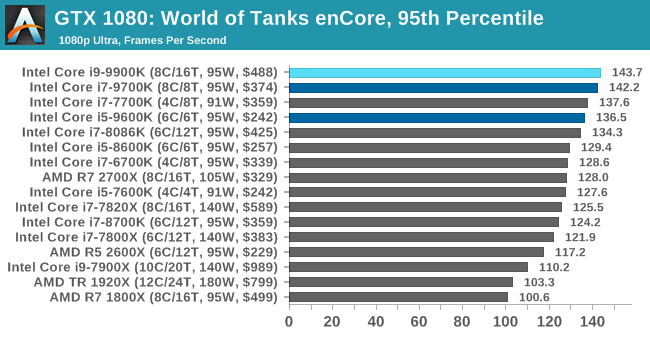
Low

Medium

High


Low

Medium

High

World of Tanks enCore, 95th Percentile
IGP
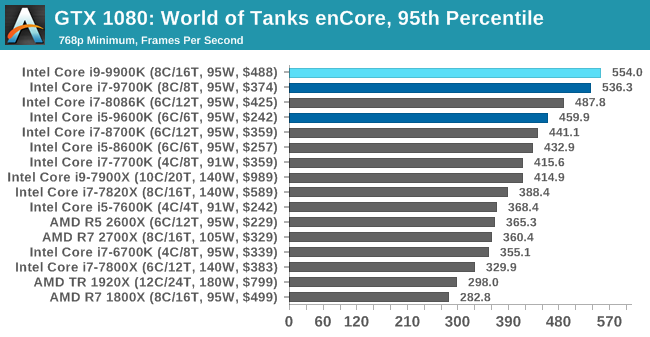
Low
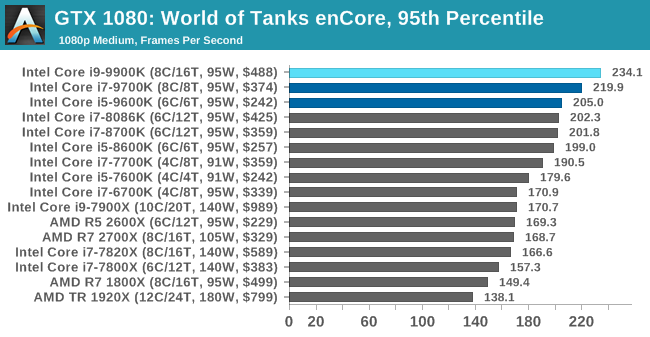
Medium

High
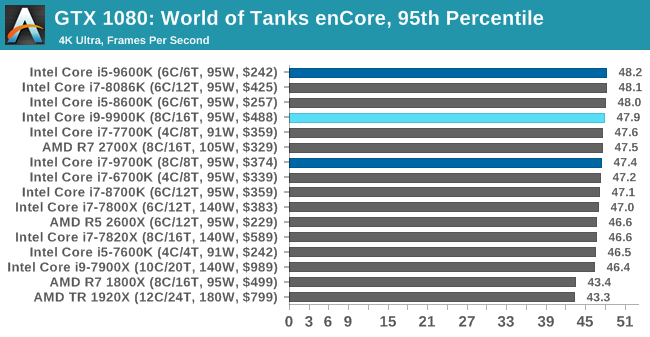

Low

Medium

High

Being a game that is not particularly limited to the GPU — at least not at low image quality settings — World of Tanks gives the 9900K processor a lot of space to show off. The game is not particularly sensitive to the number of cores, so we are talking about the high performance of each stream. And in this case, the 9900K with its turbo 5.0GHz flies forward. In fact, I am surprised at how far it has bypassed the 8086K (by 16%); this may be one of the biggest gains from 9900K, capable of raising turbo to 5.0 GHz on two cores, compared to one core on 8086K.
9700K also makes a strong impression in this test, second only to 9900K. We have several theories about this - including whether the lack of simultaneous multithreading is a plus or a minus - but nevertheless, it is obvious that the new CFL-R CPUs occupy the top two places.
However, there is a downside: any result based on processor performance melts with higher image quality settings. By the time we reached the maximum quality, the performance turned out to be limited by the capabilities of the GPU.
Final fantasy XV
Upon arrival to the computer not so long ago, the graphics of Final Fantasy XV: Windows Edition was redone because it was transferred from the console, as a result of their successful partnership with NVIDIA, with almost no mention of the production and development of the original Final Fantasy XV.
In preparation for the launch, Square Enix decided to release a stand-alone benchmark, which they recently updated. The use of stand-alone benchmark Final Fantasy XV gives us a long-term and reliable point of reference. Although it should be noted that the intensive use of NVIDIA technology by the benchmark means that it has problems with “maximum” parameters - it renders elements off-screen. To get around this, we use a standard preset that does not have these problems.

Square Enix patched the benchmark with custom graphic settings, and made corrections to give a more accurate result in the profiling of game performance, and the graphic parameters in the game. For testing, we run a standard benchmark with FRAP overlay using a 6-minute test record.

Final Fantasy XV, Average FPS
IGP

Low
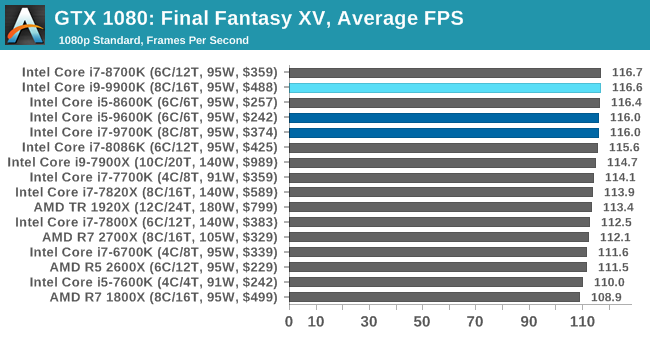
Medium
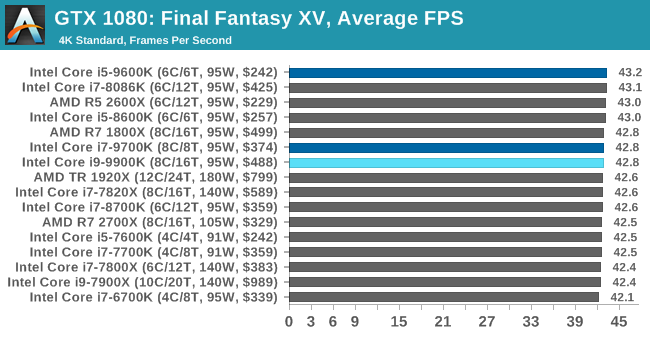
High
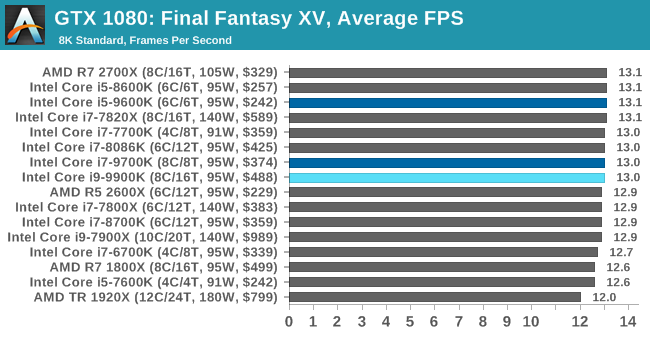

Low

Medium

High

Final Fantasy XV, 95th Percentile
IGP
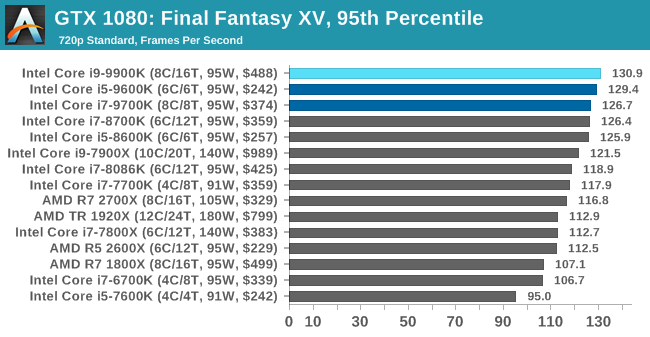
Low
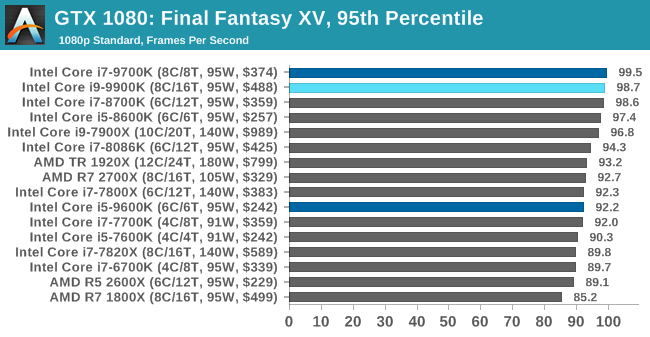
Medium
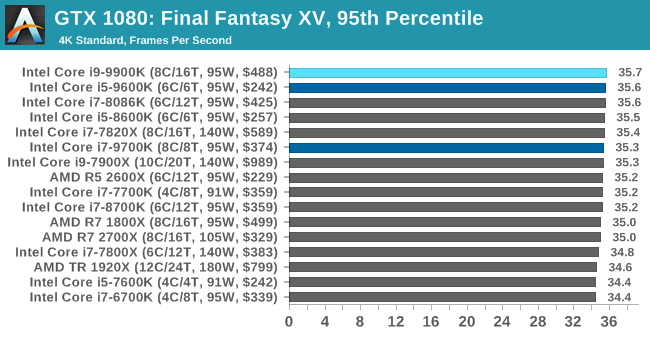
High
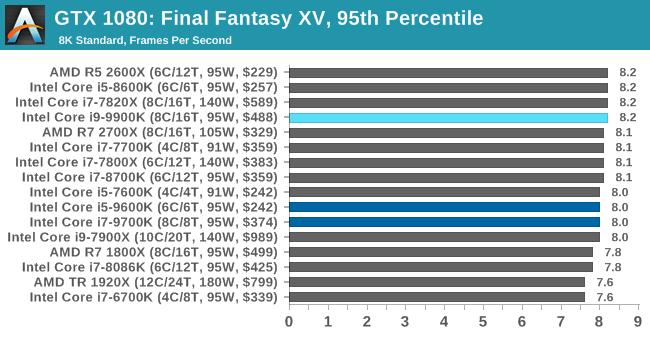

Low

Medium

High

Shadow of war
The next step is in Middle-earth: Shadow of War, the sequel to Shadow of Mordor. Published by Monolith, the last hit of which may have been FEAR, Shadow of Mordor brought the company back to the spotlight thanks to an innovative system for creating and interacting NPC rivals, under the name Nemesis System, as well as a storyline based on Tolkien's legends. The game runs on a highly modified engine, which was originally used in FEAR in 2005.

With the new engine LithTech Firebird, Shadow of War has improved the detail and complexity, as well as complemented by free high-resolution texture packages. The game offers itself as a good example - how to get the most beautiful graphics from a not very cool engine. Shadow of War also supports HDR (HDR10).

Shadow of War, Average FPS
IGP
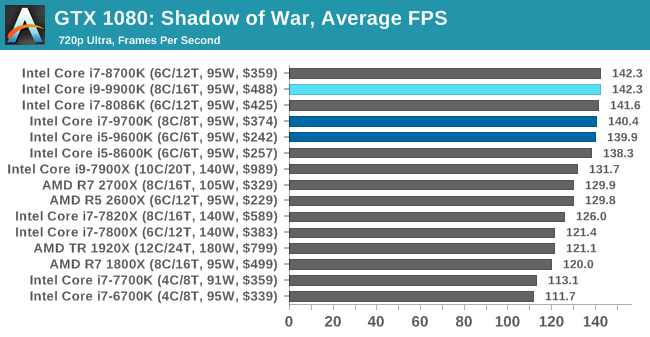
Low
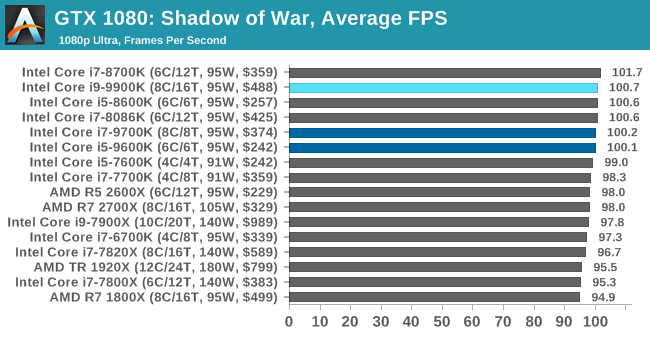
Medium
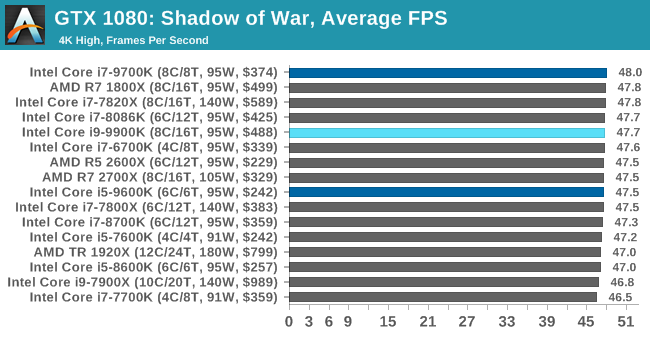
High
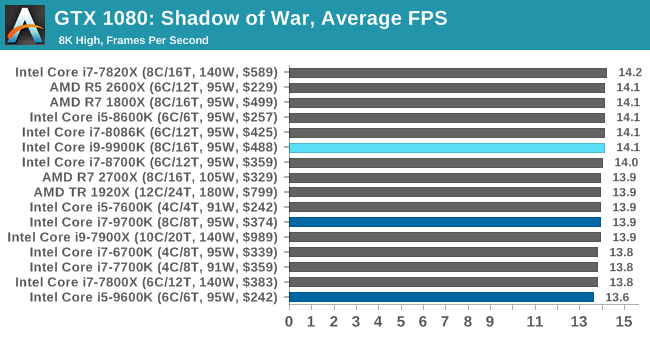

Low

Medium

High

Shadow of War is another game in which it is difficult to see the limitations of the processor with reasonable game settings. Even 1080p Ultra is a bundle of Intel processors that compete who first stumbles at more than 100 frames per second, with AMD right on its tail. The less-sensible 720p Ultra widened the gap a bit - processors with weak thread performance are beginning to fall behind - but this is still a very similar result for all Coffee Lake processors. With the highest frequencies, with a large number of cores for a desktop processor, the 9900K turns out to be the strongest contender. But this is not a game that can use all the performance of this processor.
Civilization 6 (DX12)
Originally launched by Sid Meier and his team, the Civ series of turn-based strategies became a cult classic. Many apologies were made for the sleepless nights of the players, who could not make Gandhi go to war because of the overflow of whole numbers. In truth, I have never played the first version, but I played in every part from the second to the sixth, including the fourth, voiced by the late Leonard Nimy. This is a game that is easy to play, but hard to play well.

Civilization benchmarking has always been something like an oxymoron - for a turn-based strategy game the frame rate is not particularly important, and with the right mood, only 5 frames per second is enough for a good game. However, with Civilization 6, Firaxis has hit hardcore and raised the visualization bar, trying to get you involved in the game. As a result, Civilization may require from the player a new video card and processor, especially if you play with high details under DirectX 12.
Perhaps a more in-demand result will be visible during a late game, when, in older versions, it could take 20 minutes for Civilization to make the AI players move, and transfer control to the person. The new version of Civilization has an integrated “AI Benchmark”, although at present it is not yet included in our portfolio of tests for technical reasons that we are trying to solve. Instead, we run a graphical test, which provides an example of average game settings in options.

Civilization 6, Average FPS
IGP
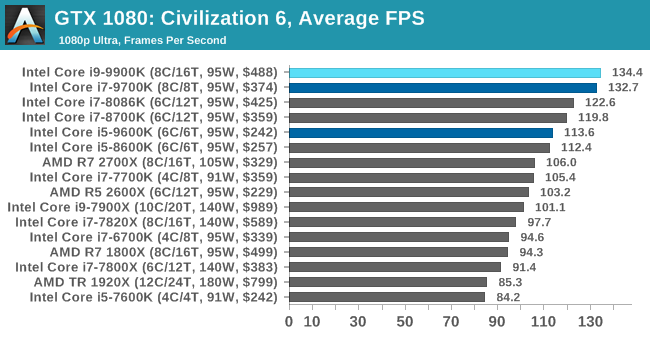
Low

Medium
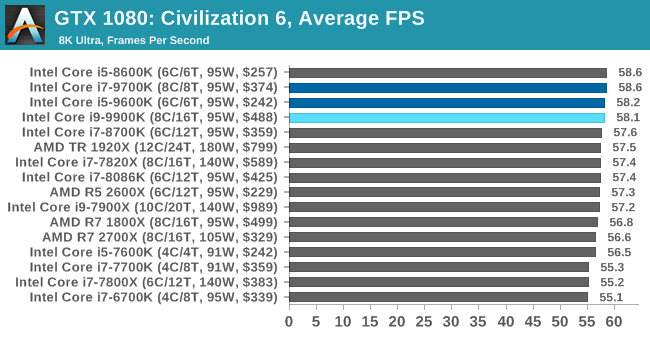
High


Low

Medium

High

Civilization 6, 95th Percentile
IGP
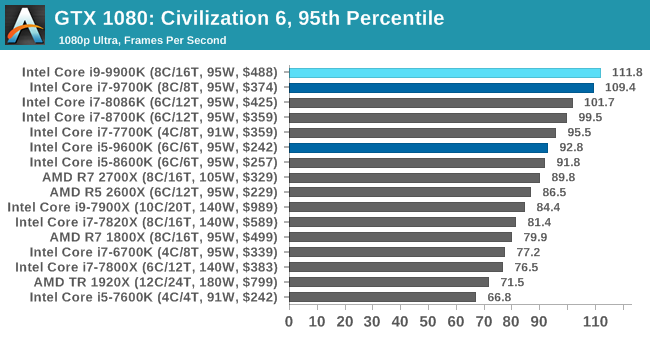
Low
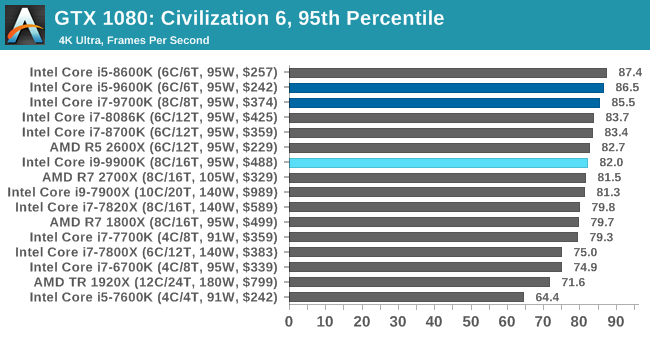
Medium
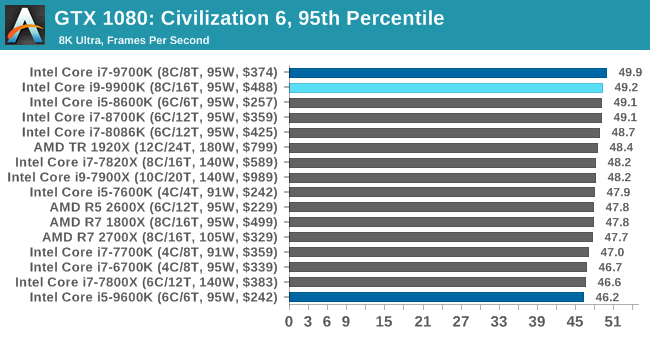
High
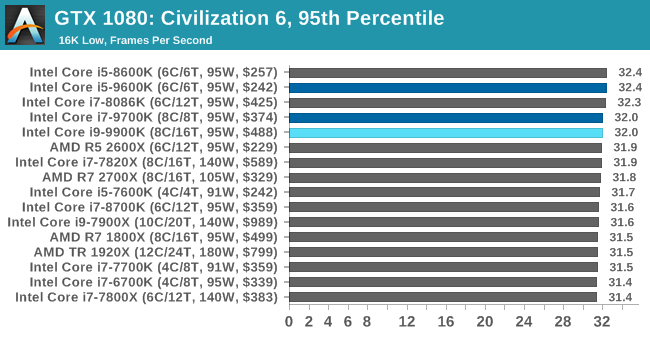

Low

Medium

High

Continuing the theme voiced earlier, Civilization 6 is another game in which 9900K does give advantages, but not in any situation. Firstly, the game doesn’t particularly rely on the GPU, so at 4K Ultra we are still not completely limited by the video card; but after about Ryzen 7 2700X, all processors start working the same way. We have to reduce the settings to 1080p Ultra in order to pull the CPU apart in different directions, after which 9900K is ahead.
This is another game that is apparently not concerned with the number of cores, as well as the frequency. Thus, 9900K has the first place, and 9700K - the second. But none of them went far from the 8700K, and the latest Intel processors are only 12% faster than their former flagship, even in these comfortable benchmark settings for the CPU.
Curiously, we also see that the 9900K loses to the 9700K processor at 4K resolution and higher. The difference is quite small and is within the margin of error, but it can be a very insignificant effect of the fact that lower-level chips should not compete for their cores for the sake of hyper-threading.
Ashes Classic (DX12)
The beloved child of DirectX12, Ashes of the Singularity (AoTS or simply Ashes) was the first name to actively explore as many DirectX12s features as possible. Stardock, the developer of the Nitrous engine that runs the game, made sure that the real-time strategy takes advantage of several cores and several video cards in the maximum possible set of configurations.

As real-time strategy is supposed to be, Ashes is a quick response both during wide open species and in mass battles. With DirectX12 at the helm, the ability to make more calls per second allows the engine to work with a significant depth of drawing units and effects. At the same time, some other RTSs had to rely on combined drawing, making the combined unit structures very rigid.
Stardock well understands the need for an internal benchmark test in the game, ensuring that this tool is available and operational from the day the game is released. This is especially important given the use of all the new features of the DX12, since it was important for the developer to understand how they affected the game. The in-game test performs a four-minute fixed battle scene with multiple shots and displays a huge amount of data for analysis.
For our test, we run Ashes Classic - an older version of the game, before updating Escalation. The old version is easier to automate, it does not use splash screen, but still has good visual accuracy for testing.

Ashes Classic, Average FPS
IGP
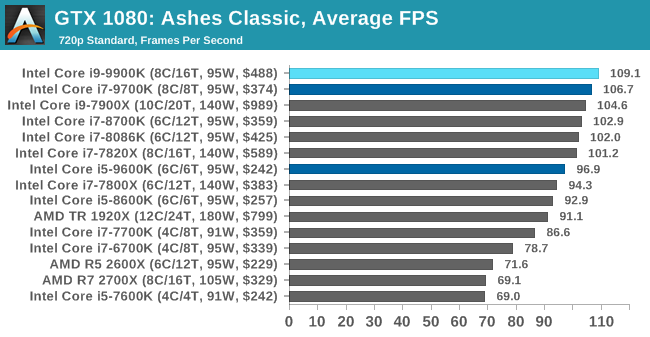
Low
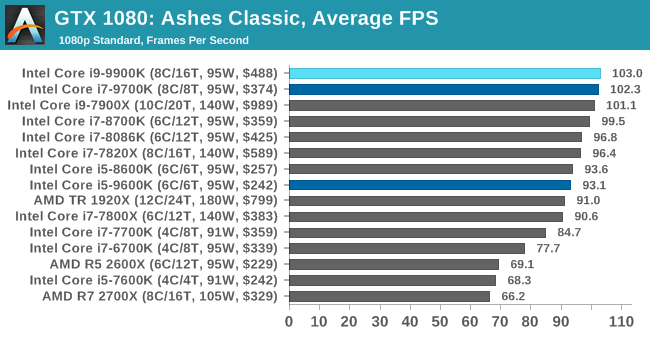
Medium
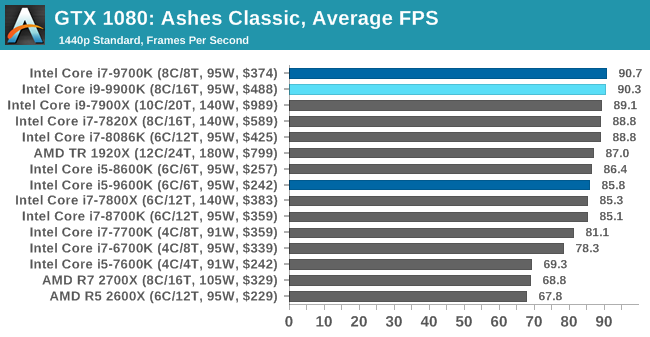
High
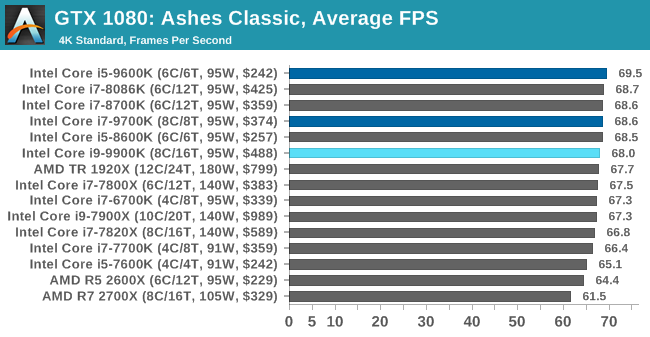

Low

Medium

High

Ashes Classic, 95th Percentile
IGP

Low
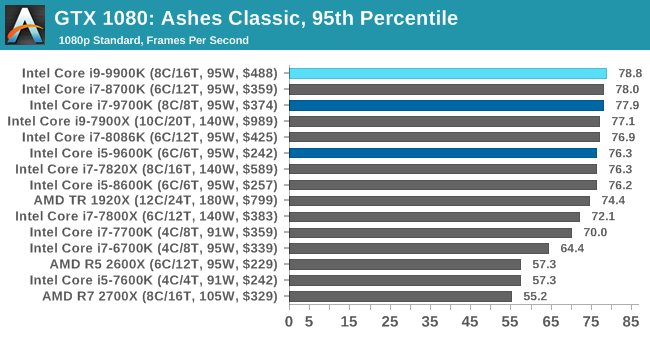
Medium

High
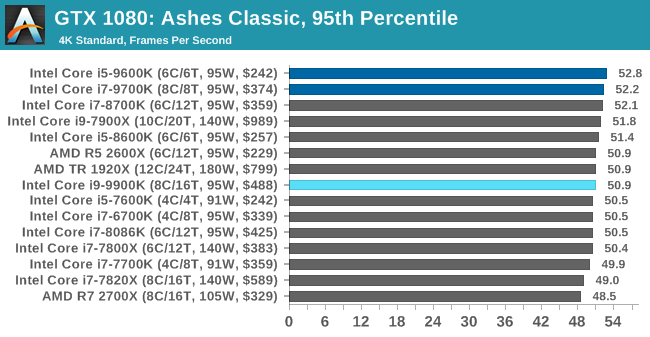

Low

Medium

High

Ashes has a drop-down menu with settings for MSAA, Light Quality, Object Quality, Shading Samples, Shadow Quality, textures and individual settings for the landscape. There are several presets, from Very Low to Extreme. We run our tests on various settings and derive the average FPS and 95th percentile.
As a game that was designed right from the start to make processors boil, and to demonstrate the benefits of DirectX 12 APIs, Ashes is one of the most CPU-sensitive tests. Above 1080p, the results are still almost the same due to the limits of the GPU's capabilities, but at 1080p or lower we get some visual separation. In this case, we see that the 9900K shows a slight advantage, putting it in first place, somewhat overtaking the 9700K that follows right behind it.
It is noteworthy that the game does not scale very much from 1080p to 720p. This makes me suspect that we are looking at a relatively clean processor shortage, a rarity in modern games. In our case, this is both good and bad for the latest Intel processor; this is by far the fastest chip here, but it doesn’t show a big margin to separate itself from the similar 8700K, having only a 4% advantage at 1080p. And this is despite its frequency and advantage in the number of cores. Thus, assuming that we do not run into the limit of the GPU, it means that we found another bottleneck (memory bandwidth? Or, perhaps, the frequency increase by 9900K does not have much weight here.
But, among other things, the 9900K and even the 9700K do really well compared to the 9600K. Whether this is a result of the number of cores or high frequency, there is a 10% advantage to these fast processors at 1080p.
Strange Brigade (DX12, Vulkan)
Strange Brigade takes the player to Egypt in 1903 and follows a story that is very similar to the story of the Mummy movie series. This typical third-person shooter was developed by Rebellion Developments, which is more widely known for its Sniper Elite and Alien vs Predator games. The game follows the idea of hunting for the Tzetkas - the Witch Queen. The gameplay is focused on the cooperative passage, with a wide arsenal of various levels and a lot of puzzles that will be solved by a group of British agents of the colonial secret service, whose goal is to put an end to its reign of barbarism and cruelty.

The game supports both the DirectX 12 API and the Vulkan API and includes its own built-in test, which offers various settings, including textures, anti-aliasing, reflections, rendering distance, and even allows users to enable or disable image blur, ambient occlusion, tessellation, etc. . Earlier, AMD boasted that Strange Brigade uses its own Vulkan API integration, which implies scalability when using several AMD graphics cards on a player's machine.

Strange Brigade DX12, Average FPS
IGP
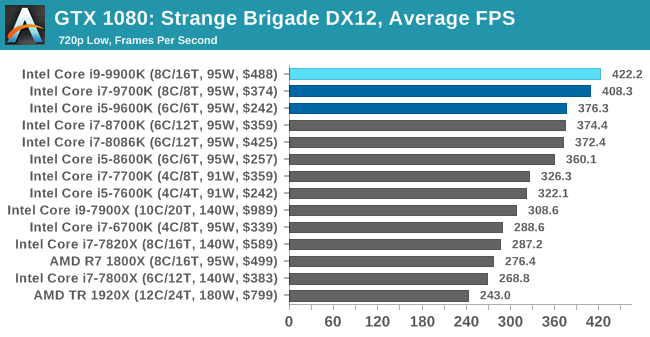
Low
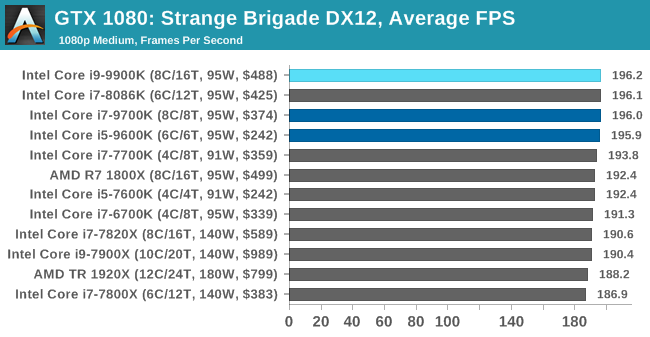
Medium
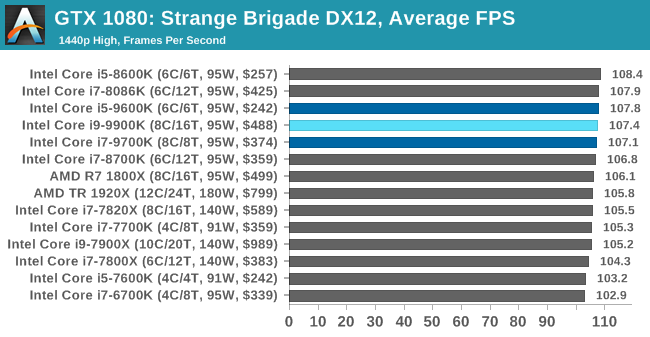
High
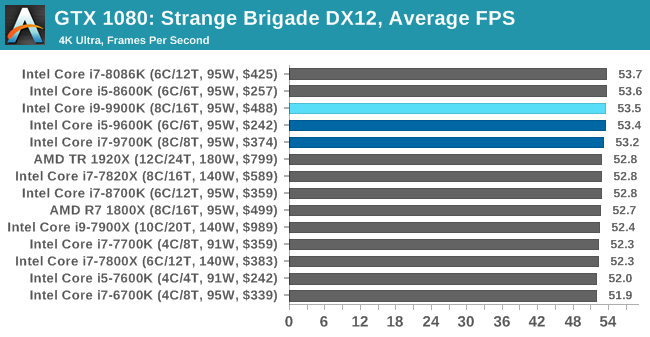

Low

Medium

High

Strange Brigade DX12, 95th Percentile
IGP
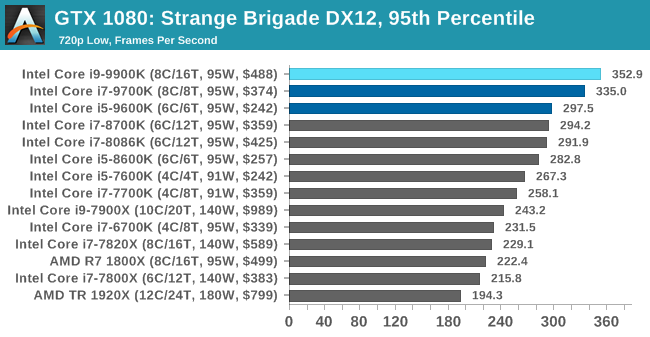
Low
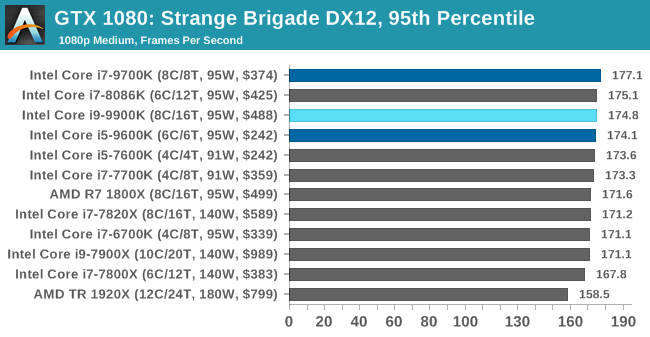
Medium

High
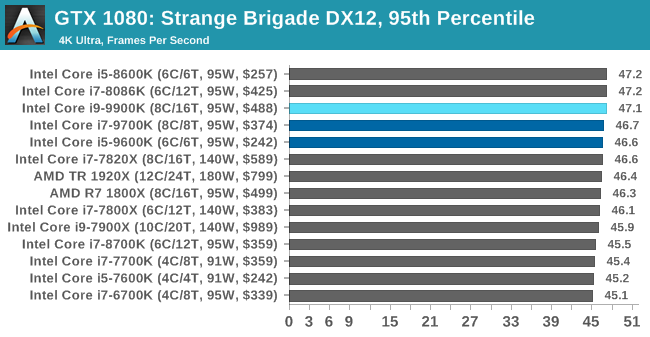

Low

Medium

High

Strange Brigade Vulkan, Average FPS
IGP
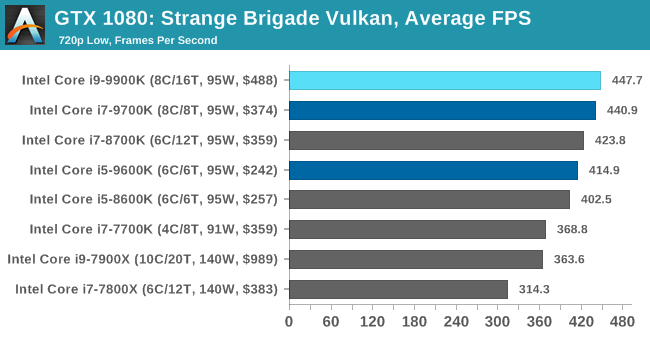
Low
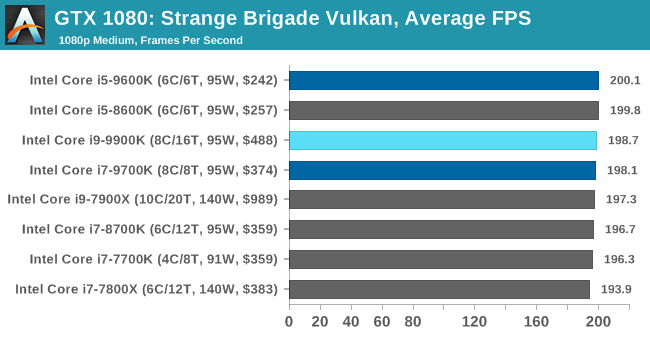
Medium
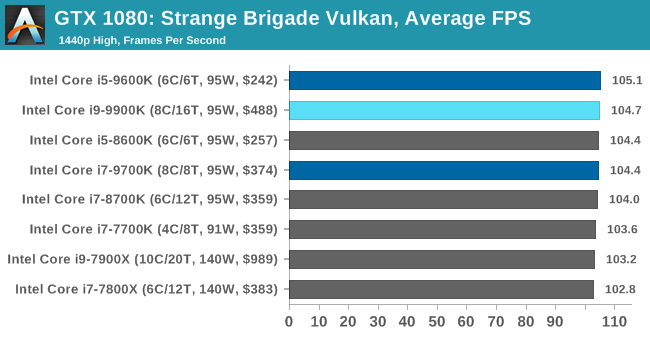
High
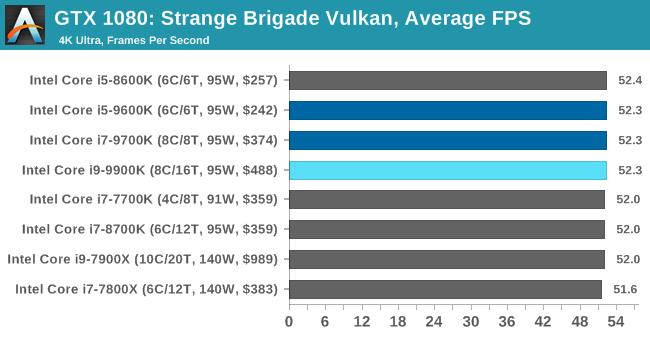

Low

Medium

High

Strange Brigade Vulkan, 95th Percentile
IGP
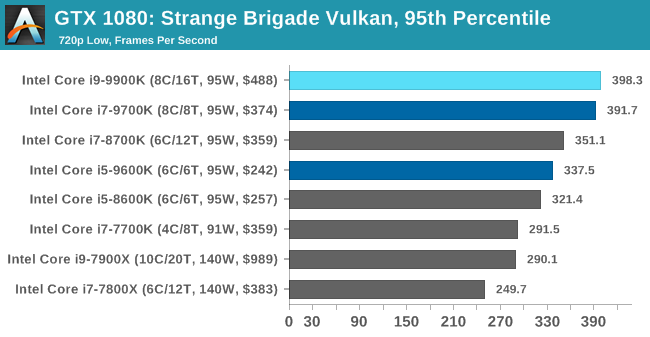
Low

Medium
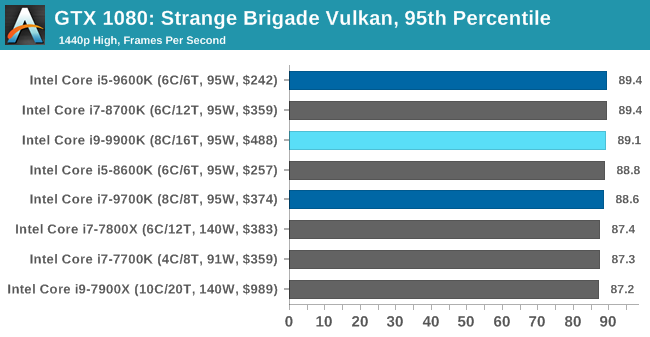
High


Low

Medium

High

Strange Brigade is another game in which it is difficult to share the results of the CPU with the default settings. We are clearly limited to the GPU at 1080p resolution, and must go down to a minimum of 720p in order to evaluate the processors. As soon as we do this, the 9900K takes the lead, and the 9700K follows right behind it. Here, the latest generation of Intel flagships is still working, and is able to offer more than a 5% performance advantage over last year’s leader. By the way, did I mention that all processors are faster than 7700K, delivering 400 frames per second or better?
Grand theft auto v
The long-awaited iteration of the Grand Theft Auto franchise hit the shelves on April 14, 2015, and AMD and NVIDIA made efforts to optimize the game. There are no graphic presets in GTA, but still the game opens up new possibilities for users and expands the boundaries of modern graphics, loading even the most powerful computers to the limit with the aid of the Rockstar Advanced Game Engine under DirectX 11. Regardless of whether the user flies high in the mountains, where you need to draw the world at long distances, or deal with sorted garbage in the city, when it is bent to the maximum, the game creates stunning visual effects, plus hard work for both the processor and the graphics card.

For testing, we wrote several scripts for the benchmark built into the game. The internal benchmark will include five scenarios: four short panoramic scenes with variable lighting and weather effects, plus a fifth - a sequence of actions lasting about 90 seconds. We decided to use only the last scene: it includes a jet flight, then a car ride through the city through several intersections, and at the end - a collision with a gasoline tank truck that explodes, like the cars around it. This is a great combination of long-distance rendering, followed by short-range rendering. And fortunately, the game gives all the necessary test results.

GTA 5, Average FPS
IGP

Low
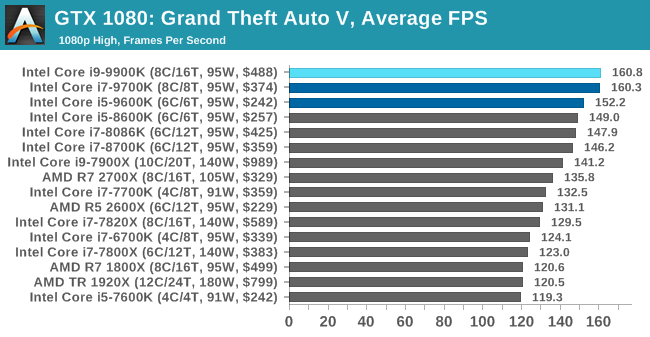
Medium
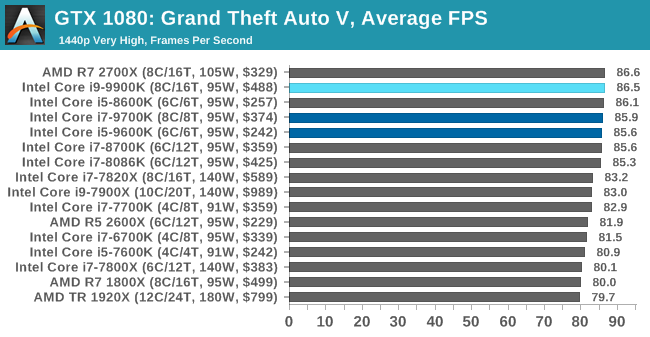
High
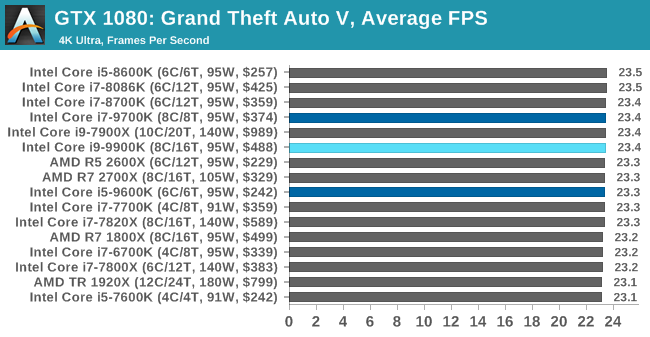

Low

Medium

High

GTA 5, 95th Percentile
IGP
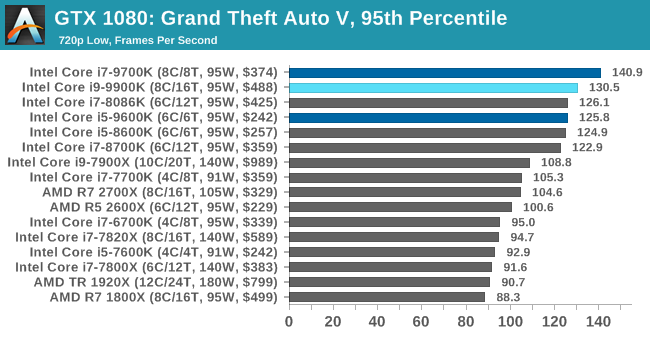
Low
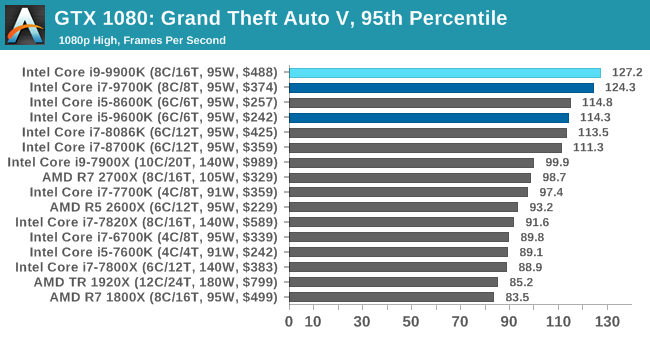
Medium

High
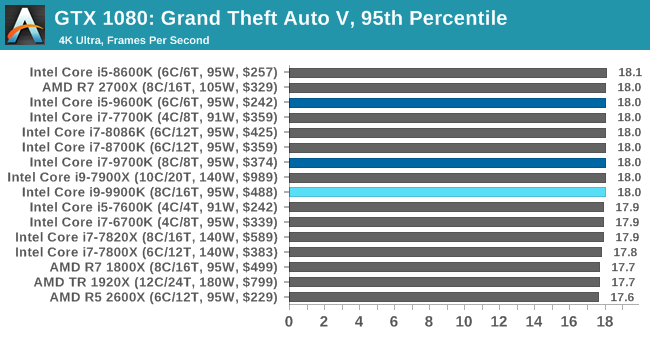

Low

Medium

High

There are no graphical presets in GTA, but the user can manually adjust parameters such as population density and drawing distance using the sliders. Other parameters such as texture / shadow / shaders / water quality switch from low quality to very high. Other settings include MSAA, soft shadows, post effects, shadow resolution, and advanced remote rendering settings. At the top of the screen there is a convenient option that shows how much video memory the game will consume with these parameters, with obvious consequences if the user requests more video memory than he has on the card (although there is no obvious hint if you have a weak GPU with more video memory, for example, R7 240 4 GB).
GTA V has always been a very exciting game, and not only because of its criminal bias. Originally released for the latest generation of consoles a few years ago - with the best processors and graphics processors from 2005/2006 - it still sells well. More importantly, it can still squeeze juices from a modern video card. And the processors are also not very easy to cope with the game, especially at high 1080p settings. In this case, CFL-R chips take 1-2-3 places, and further up to 8700K. The increase in performance is not very noticeable, but still 9900K improved performance compared with its predecessor by 9%.
However, these differences in processors quickly become irrelevant at higher, more demanding GPU settings. At 1440p Very High, we hardly see any difference in the 7 best processors, and no one issues more than 23 frames per second at 4K.
Far cry 5
The last game in the Ubisoft Far Cry series directs us directly to the unkind hands of the militarist cult in Montana, to one of the many provincial places in the United States. With a charismatic and mysterious opponent, gorgeous landscapes of northwest America and lots of violence, this is classic Far Cry. Graphically loaded game in the open world, where fighting and research are mixed.

Far Cry 5 supports Vega-oriented features with Rapid Packed Math and Shader Intrinsics. Far Cry 5 also supports HDR (HDR10, scRGB and FreeSync 2). We use the built-in benchmark to get data and report the average and minimum frame rates.

Far Cry 5, Average FPS
IGP
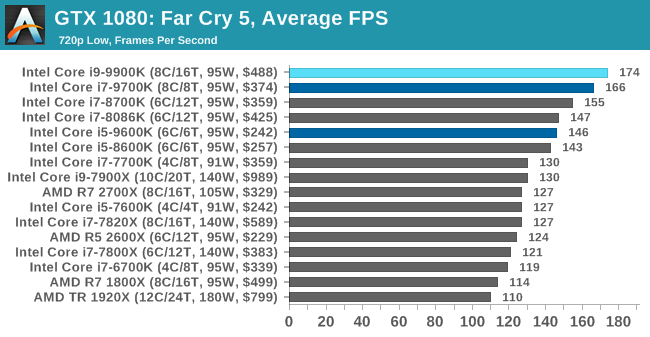
Low
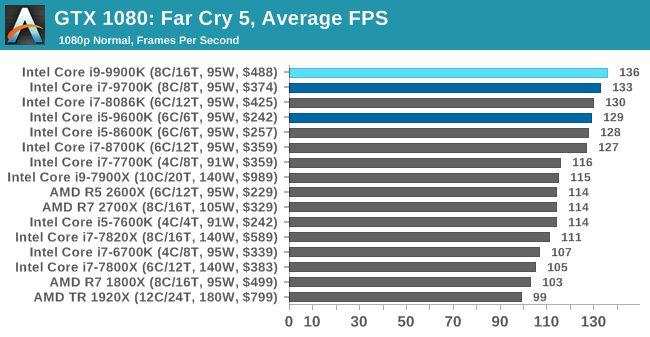
High
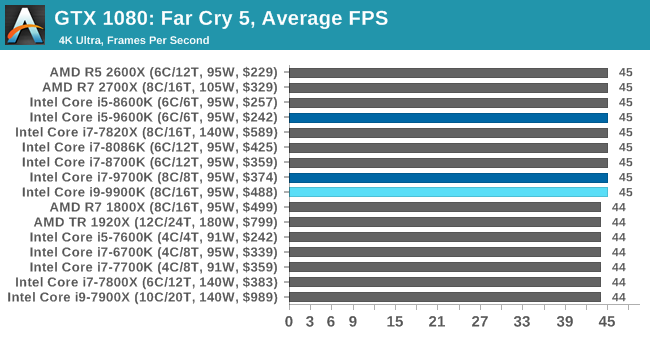

Low

High

Far Cry 5, 95th Percentile
IGP
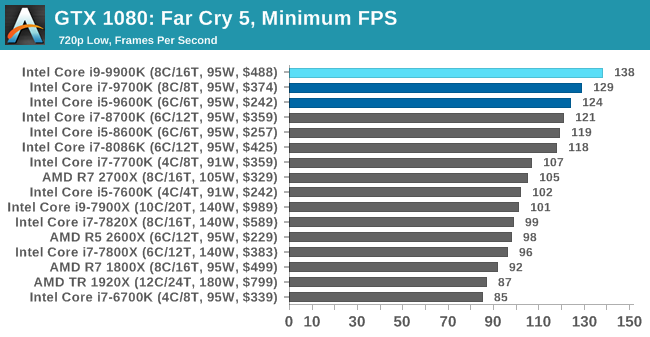
Low
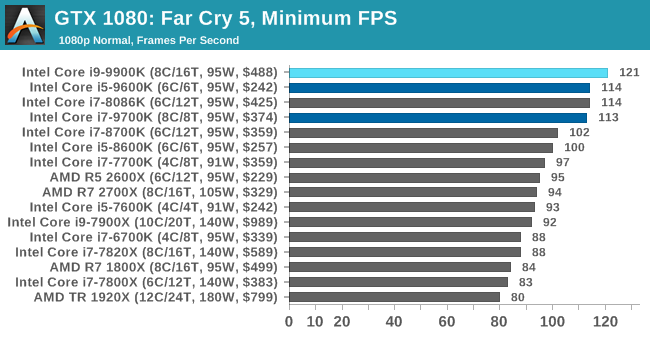
High
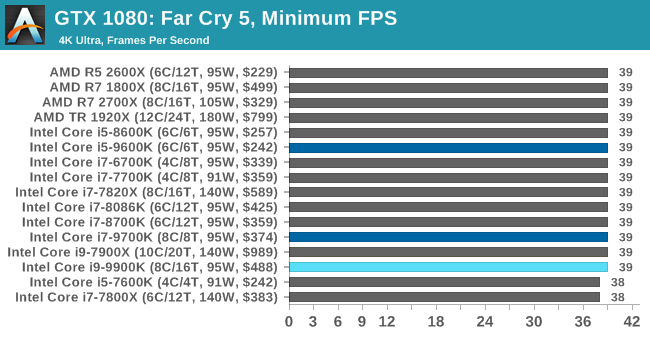

Low

High

Far Cry 5 is another game that, with reasonable settings, 1080p can demonstrate some differentiation between processors. To really see the difference between the CPU, we need to reset the settings to 720p Low, but still, in both cases, 9900K comes out on top. And in this case, the performance gap between it and the 8700K is actually a bit more than usual, this is already 12%. Nevertheless, this game, although not very dependent on the GPU, uses a limited number of threads, so the lack of large clock frequencies at 9900K does not allow it to be too far away from its rivals. It also holds 9700K in high positions.
Shadow of the Tomb Raider (DX12)
The latest representative of the Tomb Raider franchise avoids the sun, and prefers to hide in the shadows with the Shadow of the Tomb Raider. As expected, this action-adventure is again about Lara Croft, who is the main character of the franchise. Now she is making her way through the Mesoamerican and South American regions, trying to stop the Mayan apocalypse, which she herself unleashed. Shadow of the Tomb Raider is a direct continuation of the previous Rise of the Tomb Raider, was developed by Eidos Montreal and Crystal Dynamics and was published by Square Enix. The game hit the shelves in September 2018, and was released immediately for several platforms. This game actually closes the story of Lara Croft Origins, and received critical reviews after the release.

The integrated Shadow of the Tomb Raider benchmark is similar to the previous Rise of the Tomb Raider game, which we often used in the previous test suite. New Shadow of the Tomb Raider uses DirectX 11 and 12, and this particular game is advertised as one of the best implementations of DirectX 12 ever published.

SoTR, Average FPS
IGP
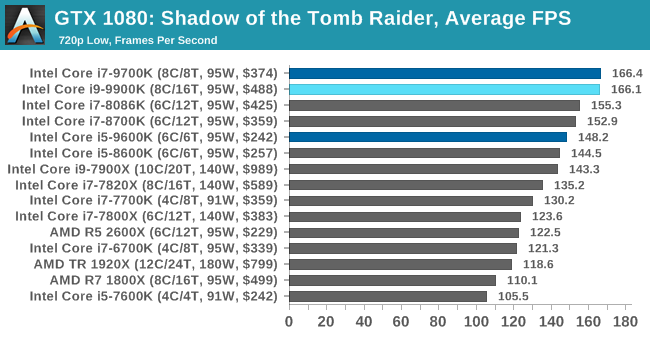
Low
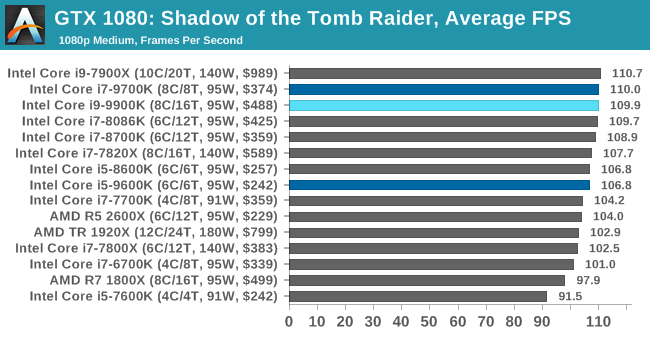
Medium
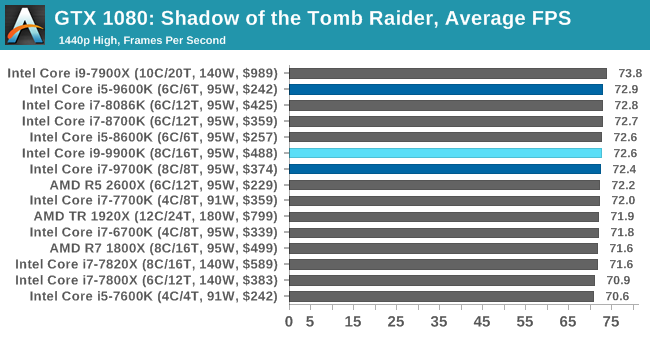
High
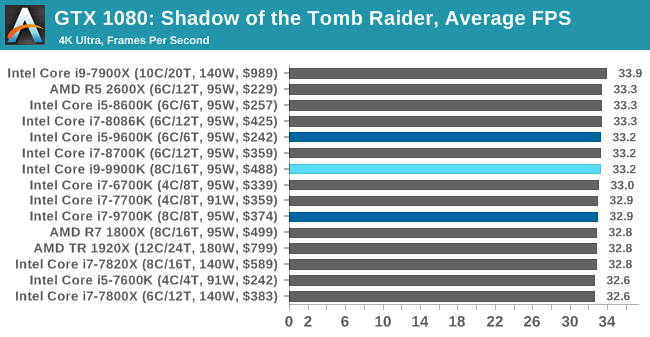

Low

Medium

High

SoTR, 95th Percentile
IGP
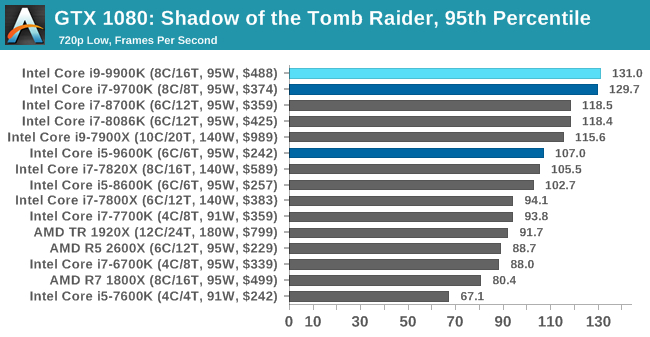
Low
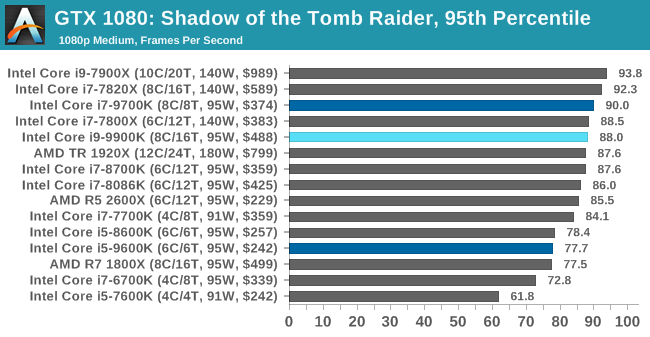
Medium

High
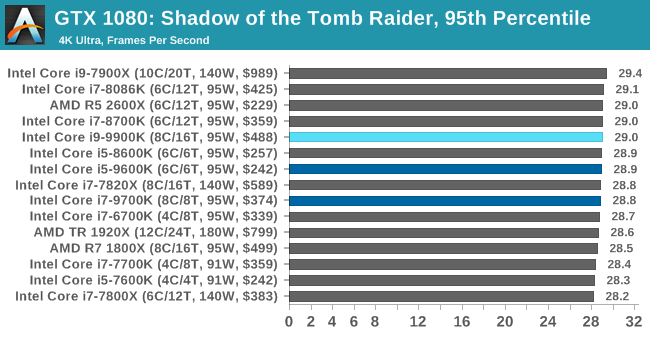

Low

Medium

High

Going deeper into the Shadow of Tomb Raider, we see another game that is mainly limited to the GPU in 1080p settings. At a resolution of 1080p, the 9900K suddenly finds itself one step behind the 7900K - a very unpleasant result, by the way, while at 720p Low it barely lags behind the 9700K. In any case, as soon as we lower our settings low enough to remove the bottleneck in the GPU, we see another typical result for the new CFL-R processors. The latest and most recent versions of Intel are several percent ahead of their predecessors, but none of the games we tested can really use the additional two cores. So all this is about frequencies and L3 caches.
Although this game (like many others) seems to reinforce the view that the 9600K is the new 8700K. The 8700K is still ahead a few frames at the settings associated with the CPU, but, despite the loss of the HT, the 9600K gives excellent results at a noticeably low price.
F1 2018
In addition to keeping the Formula 1 racing world up to date, F1 2017 added support for HDR, which F1 2018 also has. Otherwise, we would see how new versions of the Codemasters' EGO engine pave the way for F1. By claiming our rights to good graphics, F1 2018 provides a useful graphical load in our tests.

We use the built-in gaming test, which runs on the track in Montreal on a wet road, starting as Lewis Hamilton from the last place on the grid. Data is accepted for one lap race.

F1 2018, Average FPS
IGP
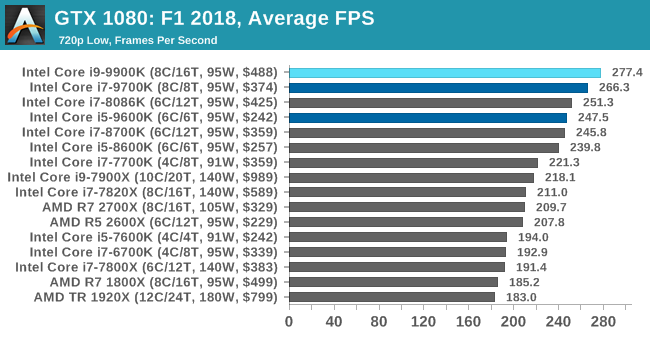
Low

Medium
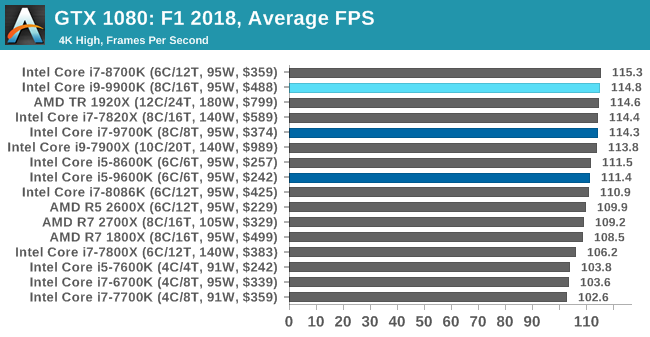
High
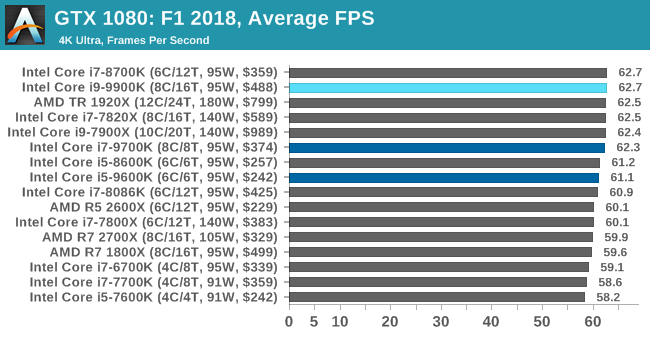

Low

Medium

High

F1 2018, 95th Percentile
IGP
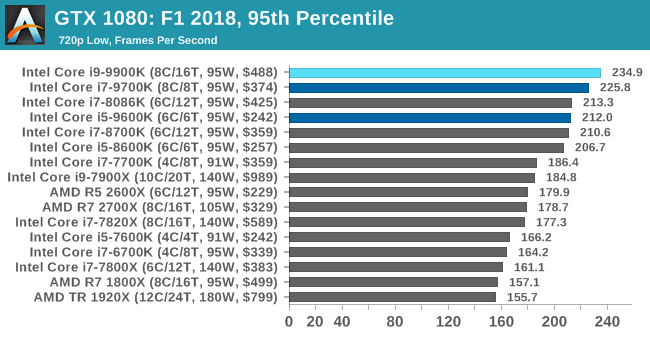
Low
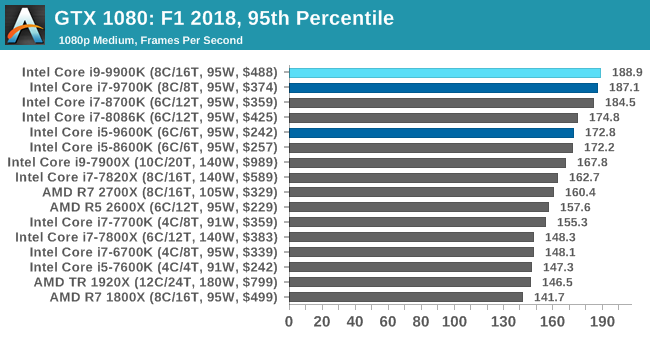
Medium
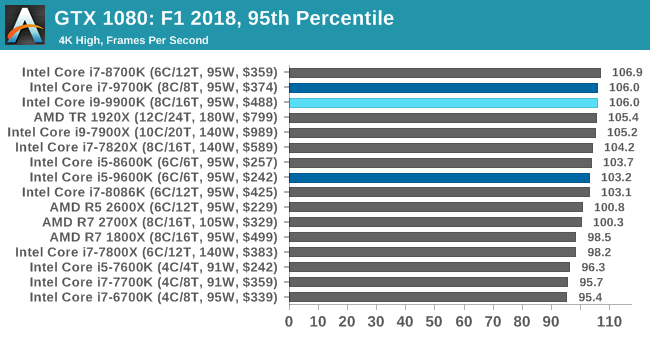
High


Low

Medium

High

Our final (and most British) benchmark is another game that is not connected to the GPU right out of the box, so it allows the processors to work a little. At the average level of 1080p, 9900K and 9700K occupy top positions, although along with 8700K, this is all within the limits of measurement error. 9700K overtakes 9900K.
Reducing the settings to 720p leads to the fact that the gap between the processors increases, and at this point 9900K takes the first place, and 9700K - behind him. The end result here is the indicator: 9900K exceeds 8700K by about 13%.
However, as soon as we get to the 4K settings (quite reasonable for this game), the game becomes much more rigidly tied to the GPU. At this point, the differences in processor performance are purely theoretical.
Integrated graphics
Despite the fact that games on integrated graphics remain the main joke on events like “bring-your-own-computer”, the game on integrated graphics can end up being as interesting as on the newest mega-device costing in the car. Over the years, the pursuit of strong integrated graphics of various shapes and sizes has been gaining - and losing - momentum. Intel relies on its latest Gen architecture, while AMD is happy to bring Vega architecture to market to absorb the entire market for low-cost graphics. Taking into account Intel, ready to make an attack on the graphics in the next few years, it will be interesting to see how the graphics device market is developing, especially integrated graphics.

To test the integrated graphics, we use our “IGP” category settings for each game, and complete the test round within five minutes, using as much data from the automatic tuning as possible.
After the tests, looking at the performance of integrated graphics, I do not believe that we managed to surprise anyone. Intel has slightly changed its iGPU since Kaby Lake - the microarchitecture is the same, and the peak frequency of the GPU has grown from 50 MHz to 1200 MHz, so the results of Intel's iGPU over the past few years have almost stalled, even in the topmost desktop PC.









In the end, there is nothing special to tell. Intel GT2 iGPU slows down even at 720p in some of these games; not that this is a very weak iGPU, but sometimes there is a big gap between its ability and modern games (which are multiplatform console ports), since these games expect some minimum GPU performance. The end result is: if you are serious about iGPU performance in your desktop processor, AMD APUs provide much better performance. However, if you are forced to play on the iGPU 9900K, then at least the main products in the eSports world, such as World of Tanks, will work quite well.
Thank you for staying with us. Do you like our articles? Want to see more interesting materials? Support us by placing an order or recommending to friends, 30% discount for Habr's users on a unique analogue of the entry-level servers that we invented for you: The whole truth about VPS (KVM) E5-2650 v4 (6 Cores) 10GB DDR4 240GB SSD 1Gbps from $ 20 or how to share the server? (Options are available with RAID1 and RAID10, up to 24 cores and up to 40GB DDR4).
VPS (KVM) E5-2650 v4 (6 Cores) 10GB DDR4 240GB SSD 1Gbps until January 1 for free if you pay for a period of six months, you can order here .
Dell R730xd 2 times cheaper? Only we have 2 x Intel Dodeca-Core Xeon E5-2650v4 128GB DDR4 6x480GB SSD 1Gbps 100 TV from $ 249in the Netherlands and the USA! Read about How to build an infrastructure building. class c using servers Dell R730xd E5-2650 v4 worth 9000 euros for a penny?
